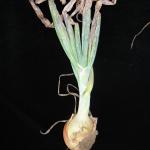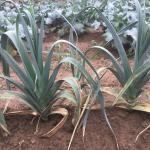Alliums, Purple Blotch
Purple Blotch of Onion
Purple Blotch is caused by the fungus Alternaria porri. It is an important disease in warm, humid onion-growing regions around the world. Garlic and leeks may be affected as well as onions. Most long-day onion cultivars are susceptible, but sweet Spanish onions are generally more susceptible than common yellow cultivars. All short-day cultivars are susceptible.
Identification:
The disease often begins on older leaves as small, sunken, water-soaked lesions with light centers. Lesions enlarge as disease progresses and turn purple to brown, often with yellow rings that create a distinctive bull’s-eye pattern. Leaves turn yellow/brown and wilt, and may be girdled. Younger leaves become more susceptible as the bulb matures. Bulbs may become infected through neck wounds. Yields may be reduced due to undersized bulbs and diseased bulbs may rot in storage. Bulb rot symptoms begin as soft, water-soaked areas; eventually, bulbs turn dark reddish-purple, then brown/black.
Life Cycle:
The pathogen overwinters in crop residue on or near the soil surface. Spores are produced and new plants infected during periods of warm (77-85°F) humid weather. Symptoms appear 1-4 days after infection and black spores are produced by fresh lesions within 5 days. Spores are produced at night and released in the morning as humidity decreases. The spores are spread by wind and splashing rain or irrigation. Typical lesions occur when the leaf wetness duration is > 16 hours; flecking may occur at 12 hours.
Purple blotch and Stemphilium leaf blight sometimes occur on the same plant at the same time. Microscopy is necessary to distinguish the two fungi; however, control measures for both species are the same.
Cultural Controls & Prevention:
Start with pathogen-free seed/sets. Proper spacing of plants and regular weeding will increase air circulation and decrease the duration of leaf wetness. Avoid excessive nitrogen. Rotate out of onions for at least three years. Field sanitation is important; remove or plow under plant debris, and cull volunteer plants. Infected plant material should be buried deeply. Harvest in dry weather and avoid injury to the necks. Allow onions to cure properly before leaf removal. Store at 34-38°F and humidity 65-70% in a well-aerated cooler. Control onion thrips if they are present, as plants weakened by thrips infestation are more susceptible to disease.
Chemical Controls & Pesticides:
For chemical control recommendations please see the New England Vegetable Management Guide.
Crops affected by this disease:
The Center for Agriculture, Food and the Environment and UMass Extension are equal opportunity providers and employers, United States Department of Agriculture cooperating. Contact your local Extension office for information on disability accommodations. Contact the State Center Director’s Office if you have concerns related to discrimination, 413-545-4800 or see ag.umass.edu/civil-rights-information.



